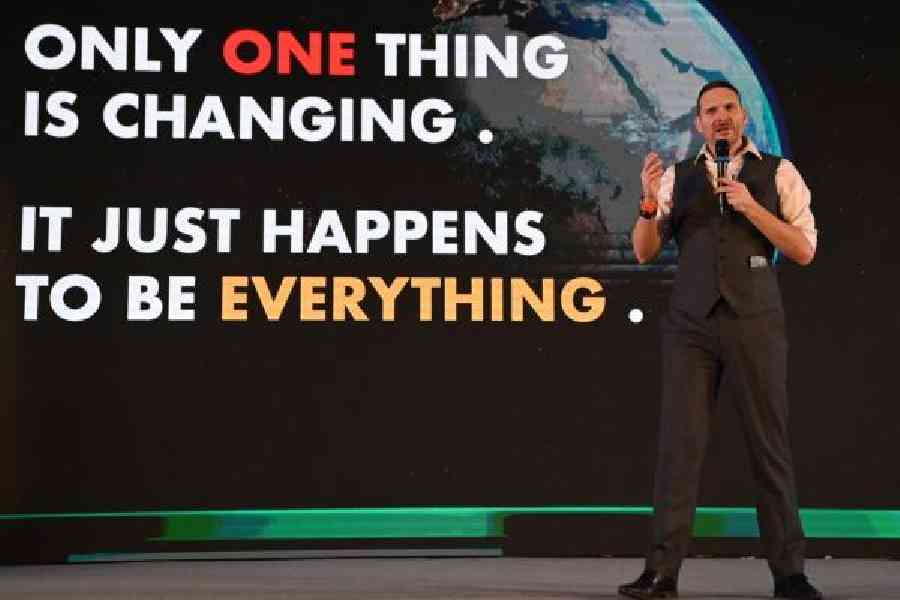What’s the future of artificial intelligence and, more importantly, how can it help us? Award-winning Futurist Matthew Griffin, often described as a “walking encyclopaedia of the future”, has thoughts, which he unloaded on the sidelines of Infocom 2024, the 23rd edition of the ABP Group’s flagship event.
Matthew is is the founder and Futurist in chief of the 311 Institute, a global Futures and Deep Futures advisory firm.
Where are we on the AI arc…
Companies in India want to get an understanding of what the future could look like. What’s going on in the world today? What does that mean for them tomorrow? What are the opportunities and threats? It’s a bit of doing a smorgasbord. Once we’ve started walking through what’s happening, what the impact of all these different things are on businesses, the government, countries, their consumers, then we start bringing it back down and say: ‘This is now how you how you benefit from this.’
Indian population and AI opportunities…
On the one hand, when we look at large Indian technology giants, including financial services organisations, while they’ve been embedding artificial intelligence into their products and while they’ve been building their sovereign artificial intelligence, the general perception globally is that Indian artificial intelligence programmes and projects are probably about five years behind, for example, America, and five, maybe six years, behind China.
We are increasingly finding services and technology organisations building out huge campuses. And I would say over the past two years, the amount of conversations that we’ve actually seen globally where India has been included in artificial intelligence-related conversations has tripled. We see ambition, which I think is one of the most important measures of how determined you are to actually change something, change the status quo, Indian ambition is now really starting to go up. As you see ambition scaling, you start seeing investment scaling, so you’re seeing huge amounts of foreign direct investment flowing into India, especially in the tech and biotech sectors. As ambition grows, you start educational changes, you see more skilled people or highly skilled people starting to come through and you see more entrepreneurship.
India is obviously trying to develop its export market. But at the same time, India also has a huge internal domestic market, which is now starting to swing into action.
Areas of focus…
The first two areas I always say we should focus on are education and health. If someone’s educated, they have a better opportunity to get a job, have a career, and end up being in a higher-paid role. However, none of that matters if they don’t have their health.
However, when you have a look at climate change, I think one of the big challenges that India is going to face increasingly is going to be domestic food supply.
If you think climate change will only worsen, agriculture and food security will become much more important. So that’s where we can have a look at things like precision agriculture, but that’s also where we can have a look at things like vertical farms and cellular meats.
Misinformation and disinformation
When you have a look at India’s Internet, like we saw with the local elections, there is a huge amount of misinformation and disinformation coming. As the world’s largest democracy, India is absolutely a prime target for people who want to tear democracies down.
So when we look at things from a security perspective, it’s increasingly easy to use artificial intelligence to create full synthetic content. It’s not just deepfakes, which are a manipulation of existing content. However, with our ability to use artificial intelligence to create brand new synthetic video from scratch, from a text prompt, all of a sudden, different actors using social engineering can start sowing division within the Indian community, as we’ve seen in America, which is a highly polarised society now.
When you have a look at it from an Indian perspective, there have been conversations about a sovereign Internet where ultimately, because India is connected to the global Internet, your ability to stop actors in other countries who want to try to harm you, tear you down, change the status quo, manipulate opinions and behaviours, need to be tackled. This is where some of the Indian organisations come in to limit the risk of artificial intelligence content while still preserving the integrity of Indian freedoms and Indian democracy.
Chip diplomacy
In terms of overall ambition, China is building China for China. When you look at road initiatives, for example, it benefits Chinese companies, Chinese construction companies, Chinese investment companies and Chinese workers. That’s one of the things that I think quite a lot of different countries sort of miss or maybe underrepresent. If we have a look at America, America under Trump is going to be America first. Europe is becoming a little bit Europe first because Europe used to import technology services from America and manufactured products from China and suddenly realised that as China sort of swings one way and as America swings another way, Europe was, well, hang on, we do rely on other people.
The lessons that I would suggest India takes on and learns involves increasing your ambition 10x.











